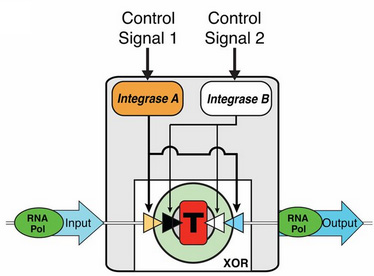Stanford scientists have created a computer inside a living cell
 In the XIX century, Charles Babbage, developing the design of his computer, relied on mechanical elements. ENIAK, the first modern universal computer, created in the mid-40s, was based on the features of the operation of vacuum tubes. Today, computers use transistors based on semiconductor elements to conduct logical operations.
In the XIX century, Charles Babbage, developing the design of his computer, relied on mechanical elements. ENIAK, the first modern universal computer, created in the mid-40s, was based on the features of the operation of vacuum tubes. Today, computers use transistors based on semiconductor elements to conduct logical operations. The team of bioengineers at Stanford University, in turn, created a logical element from genetic material, which was called a biological transistor or transcriptor. They reported this in the journal Science on March 28 of this year.
In the publication, researchers described a universal system of genetic transistors within a functioning cell that can turn on or turn off under certain conditions. The authors of the study hope that over time, such groups of transistors can become microscopic living computers.
Computers of this kind can perform various tasks: to determine the presence of any toxin, to count the number of divisions of a cancer cell, or to provide detailed and accurate information about the effect of the drug on any type of cell. For example, to avoid the uncontrolled division of cancer cells, you can program the computer inside the cell to die when a certain threshold for the number of divisions is reached.
 Drew Andy (pictured) hopes that in the future it will be possible to place miniature computers in any living cell, however, he notes that there is no talk of replacing silicon microelectronics. It is not expected to replace the silicon filling of phones or laptops with live computers, but computers will work where silicon could never.
Drew Andy (pictured) hopes that in the future it will be possible to place miniature computers in any living cell, however, he notes that there is no talk of replacing silicon microelectronics. It is not expected to replace the silicon filling of phones or laptops with live computers, but computers will work where silicon could never. The team demonstrated the work of biocomputers using the E. coli bacteria as an example, which is very typical for genetic research. Transcriptors use specific enzymes to control the flow of RNA polymerase along DNA strands in the same way that millions of silicon transistors in computers control the flow of electrons. The choice of transcriptor enzymes is a time-consuming and important task, since they must be functional both in bacteria and in fungi and animal cells.
Like conventional silicon transistors, transcriptors allow a small current to control the behavior of a larger one. A small change in the activity of the enzyme (transcriptor gate) will lead to a large change in the associated genes (channel). By combining transcriptors, the researchers created a complete set of Boolean logic elements - the biological equivalents of AND, AND-NOT, OR, exclusive OR, and exclusive NOT-OR. With a set of such elements, a biological computer will be able to perform calculations inside the cell.
To carry out calculations in the cell, however, a biological device for storing data is required, and experiments on coding information in genetic material have already been carried out. You should not expect the rapid emergence of productive biological computers, but it is quite possible the spread, for example, of a new type of medicine. In the hope of developing biological computing technology, Stanford researchers have turned the design of (bio) logic elements into the public domain.
Based on ExtremeTech and Stanford School of Medicine sites .
